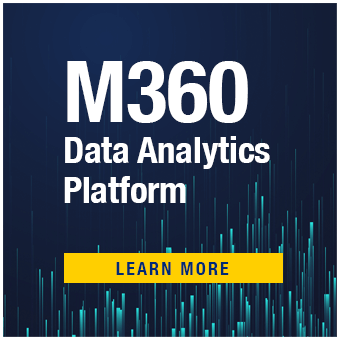Becoming data-driven is a priority for most companies today and the reasons are clear. According to consulting firm McKinsey, data-driven organizations are 23 times more likely to acquire customers, six times as likely to retain customers, and 19 times as likely to be profitable.
The data says … use your data!
Most credit unions don’t need to be convinced about why. They understand that data is key to serving today’s digital member in the ways they expect. But how to become a data-driven credit union isn’t always straightforward. Most credit unions are surprised to discover there isn’t a sequential series of steps or “right way” to move forward on the journey.
In fact, thinking about the data journey as a single defined path might just be what’s holding you back.
Data Maturity: A Journey with No Final Destination
Even the phrase “data maturity journey” can be a misnomer if it leads someone to believe it starts at “point A” and ends at “point B.” This makes for a nice, neat visual – but in our experience, reality is much different. And, that’s a good thing! Here’s why.
- It can be overwhelming to feel a long list of steps must be taken before your credit union can even begin to use more sophisticated data analytics. We have seen firsthand that it’s possible for willing and eager credit unions to quickly begin using advanced analytical models.
- Every credit union is different. Even within the same credit union, data needs will be multi-dimensional and dynamic across the organization. One department may need trend forecasting, another data management, and another behavioral insights – each of which can fall into different parts of the typical data maturity model. As needs and goals differ, there simply won’t be a template process that works universally.
- A linear journey implies a final destination: once you reach it, you’re done. Not only is this unrealistic, it can actually be detrimental. Market forces, financial conditions, trends, and behaviors are always changing. Even the most data-savvy credit unions will need to regularly adapt and improve how they use data analytics over time. There is no set point at which all data potential has been achieved.
- A linear path is process-based and not outcome-based. The best path for each credit union will be unique and determined by identifying goals – not working through a set series of steps and hoping you end in the right spot. The most meaningful data will be directly tied to a credit union’s strategic priorities.
- And last, but certainly not least, becoming data-driven isn’t solely a technological shift – it’s a cultural one. Being successful requires a credit union to chart its own path through leadership-led change management that moves the organization away from making decisions based on “gut feelings” or experience and toward new data-guided actions.
The Four Data Pillars You May Encounter on Your Journey
Though every credit union’s data journey will be unique, most will encounter four data pillars along the way. There are no hard-and-fast rules about approaching the pillars in a certain order (but there are recommended practices that will help to maximize insights and optimize decision- making). Credit unions can even work within multiple pillars at the same time.
Where you begin depends upon your objectives. Following are descriptions of each pillar and sample objectives to help identify which data pillars are priorities for your credit union.
Pillar 1: Data Management
Data management is a framework of data disciplines that organize a credit union’s data to maximize value. It creates a foundation to ensure data is accurate, up-to-date, and accessible.
This pillar is a natural starting point for credit unions that are beginning to define their data strategy, but it plays a fundamental role in every stage of the journey.
Sample objectives:
- Our credit union wants to break down silos and centralize our data.
- Our credit union needs an architecture in place to store and integrate the use of data organization wide.
- Our credit union wants to improve data quality to obtain the best insights.
Pillar 2: Descriptive Analytics
Descriptive analytics makes use of large amounts of historical data, providing insights into what has happened by aggregating information and summarizing the findings. It is a place to start for credit unions interested in monitoring performance and trends by tracking KPIs and other metrics.
Sample objectives:
- Our credit union wants to more deeply understand our members through data such as: acquisition channels, product usage, lifetime value, or channel preference by persona.
- Our credit union wants to understand how frequently certain events occur.
- Our credit union wants to monitor and benchmark metrics such as product performance, deposits, loan growth, or how we compare to peers.
Pillar 3: Predictive Analytics
Predictive analytics makes predictions about the future to enable proactive decisions. Algorithms are used to identify historical trends and accurately anticipate what might happen in the future. Predictive analytics can allow credit unions to automate decision-making processes, saving time and freeing up resources that can be put to better use elsewhere.
Sample objectives:
- Our credit union wants to proactively offer members the next most relevant product or service for their financial needs.
- Our credit union wants to target the member segments likely to embrace a new product or service.
- Our credit union wants to know which members are most likely to leave our credit union in order to find ways to effectively re-engage them.
Pillar 4: Prescriptive Analytics
Prescriptive analytics helps choose the best course of future action by advising on possible outcomes. Based on the data and scenarios analyzed, prescriptive analytics recommends specific actions and strategies by employing advanced analytical techniques.
Sample objectives:
- Our credit union wants to understand the impact of product decisions, such as examining credit line increase scenarios.
- Our credit union wants to understand which member re-engagement strategies are likely to be most effective.
- Our credit union wants to proactively prepare for the impact of various economic conditions, such as rising interest rates or unemployment levels.
The process of becoming data-driven is less of a straight line, and more of a “choose your own adventure.” Perhaps a better analogy moves from path to puzzle, where each credit union puts together the pieces of their own evolving picture.
Regardless, your credit union can chart its own path, and paint its own picture.
Read the original article on CIUInsight.










